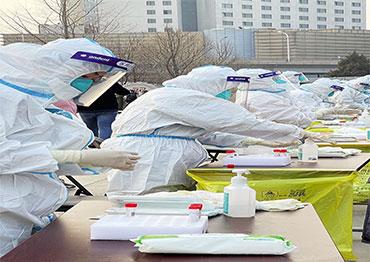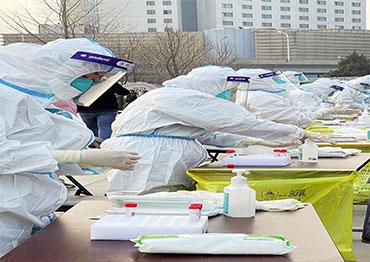After the Covid-19 outbreak in Wuhan, the first epicenter in Central China’s Hubei Province in early 2020, nucleic acid tests were in such high demand that it was difficult to get an appointment. However, individual tests have become more available since China brought the coronavirus under control last summer. Now, tests only take several hours, and test records and health code apps are necessary for long-distance travel within the country.
In 1983, American scientist Kary Mullis invented the polymerase chain reaction (PCR) process, making it possible to replicate minuscule amounts of DNA into unlimited quantities. It is the most widely applied method for nucleic acid testing.
Xiao Yanqun, director of the Department of Molecular Pathology at the Shanghai Center for Clinical Laboratory, told NewsChina that more than 9,000 people at the center are certified to conduct PCR nucleic acid tests. Shanghai has more than 120 PCR laboratories, over 70 of which opened last year.
In April 2020, China’s National Health Commission (NHC) said that all disease control and prevention institutions above county level should be able to conduct nucleic acid tests. In August 2020, the State Council, China’s cabinet, announced that as of the end of September, each county should have at least one hospital able to conduct tests.
As a result, PCR labs opened nationwide. In Shanxi Province, 108 counties had PCR labs. The number of test-capable medical institutions reached 174 by late August 2020, compared to only 14 the previous year.
Liu Weiyong, a lab technician at Huazhong University of Science and Technology’s affiliated Tongji Hospital in Wuhan, told the reporter that before the outbreak, few major hospitals in the city had automatic nucleic acid extraction equipment.
From 2015 to 2019, Sansure Biotech, a major domestic PCR instrument manufacturer, produced nearly 1,000 kits. In 2020, the company sold more than 6,000. He Tenglong, managing director of Puhua Capital, which invested in medical enterprises working in coronavirus-related tech, said some PCR manufacturers received far more orders than they could fulfill.
At a press conference on January 13, 2021, Guo Yanhong, an official with the NHC’s Bureau of Medical Supervision, said that 8,437 medical institutions nationwide have a daily testing capacity of 12.55 million samples.
Nucleic acid testing, however, is not 100-percent accurate and can require several rounds. Between January 2 and 12, 2021, 610 people in northern China’s Hebei Province tested positive for the virus. One man had reportedly shown persistent symptoms for over a month. He tested positive on his 11th test.
Yang Qixian, CEO of Shenzhen-based Broadx Biotech, told the reporter there were many medical conferences in the past year which discussed how to improve testing accuracy. The consensus among experts is that misdetection rates are likely to remain as high as 20 to 50 percent regardless of developments in technology.
Wu Zunyou, chief epidemiologist with the Chinese Center for Disease Control and Prevention, told NewsChina that the test’s inaccuracy makes mass testing unnecessary. “Testing can give both the public and government officials a false sense of security,” he said.
During local outbreaks, test results are valid for shorter periods, requiring people to test more frequently. For example, people coming to the Chinese mainland from Hong Kong must provide test results received within 24 hours. On January 9, 2021, many residential communities closed in Beijing’s northern Shunyi District after new cases were reported. Those who wanted to leave had to provide negative test results, which were only valid for 48 hours.

 Old Version
Old Version
